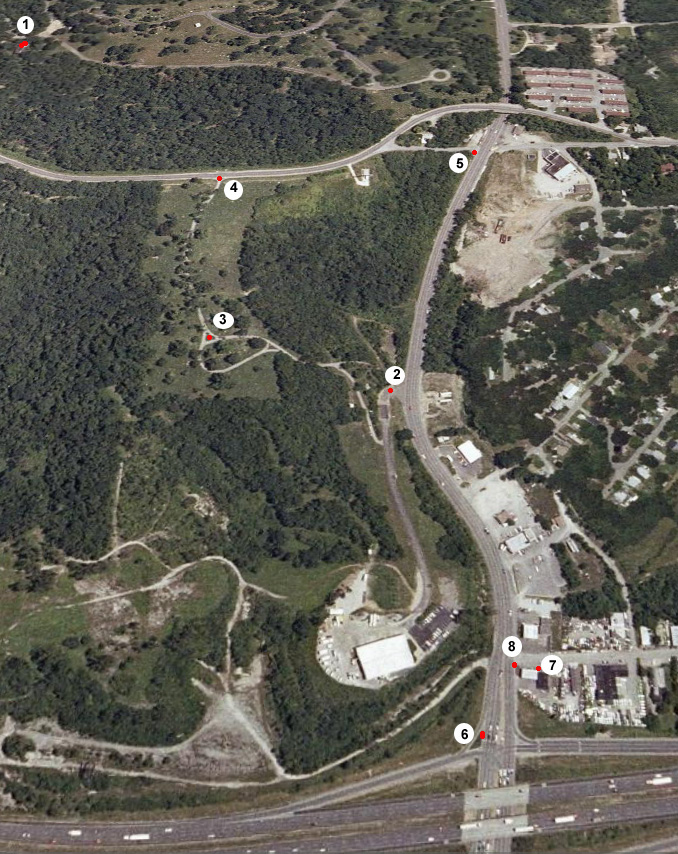- The William Rockhill Nelson Mausoleum in Mt. Washington Cemetery, where Anastasia was originally asked to meet Justin
Bruton, and where he and two others later returned with her. They were spotted by the cemetery's caretaker, and moved on from
there. The question is, why did they return to this out-of-the-way spot, where they had earlier asked her to meet them?
- The back entrance to Lincoln Cemetery, off of Truman Road. This is the road that Justin Bruton drove up
into Lincoln, and is also the path that Anastasia would have had to have walked if she had gotten
out of Bruton's car as per her killer's alibi. It was three hundred feet in the wrong direction from her home, up a
fairly steep incline, and the road to the cemetery (the narrow path going back east) is extremely difficult
to spot from Truman Road in daylight, due to the trees (dark green) that are between it and the lower road,
and virtually impossible to see in twilight, as would have been the situation per her killer's alibi. It was a key
component of his alibi that Anastasia had to voluntarily take this path, but there is no logical or
reasonable explanation for why she might have done so.
- The Killing Field. This is where Anastasia WitbolsFeugen was shot and killed. The red mark shows
where Anastasia's body was found, and Justin Bruton's car was on the road to the right of the mark.
- Front entrance of Lincoln Cemetery. This is where Justin Bruton's car, driven by Anastasia's killer, exited
the cemetery, and headed south (right) toward Truman Road.
- Truman Road and Stark. This is where the car got back onto Truman Road and headed east (down) toward
Justin Bruton's condo. It is also the spot where Justin Bruton told Anastasia's family (when he called them
that night) where she had gotten out. Anastasia's killer also told the same story to a friend a day or two after that,
though he maintained a different location later to police. Note that this exit point would have meant that
Anastasia would have had to have walked further away from her home in order to have ended up at the
cemetery.
- This is the spot where the killer later claimed to police that Anastasia had gotten out of the car and
stormed away, apparently into clutches of a random killer. It is approximately a quarter-mile (two city
blocks) to the road leading to Lincoln's back entrance (2), and another quarter-mile to the intersection
of Truman and Stark(5).
- Don Rand, a mechanic at the Amoco station, usually worked toward the back of the station.
- The day after the murder, Mr. Rand told investigators that he was in the front of the station the
previous night, and that he saw an attractive woman walk past late that evening. He was shown Anastasia's
photograph (and none of any other females) and guessed it to be the woman he saw. He recounted that he had
seen a medium-height woman (about 5'7" or so, according to his statement) walking away from an eastbound car.
On the stand, Mr. Rand testified that he saw an attractive medium-height girl get out of an eastbound car on
the south side of Truman Road and angrily walk away from it on the same night that Anastasia was murdered; his
testimony was used by Case to try to prove his alibi.
Under cross-examination, however, Mr. Rand admitted that he had told police the day after the murder that he
did not see the woman talking to anyone, and that he could not tell whether or not she was in any way upset.
In short, the killer's alibi, in order to be true, required that Mr. Rand had seen an attractive, noticably short
young woman arguing with the occupants of a westbound car and then angrily storm away from
it on the other side of the road.
What Mr. Rand did see was an attractive, average-height woman calmly walk away from an
eastbound vehicle on his side of the road, with no indication as to having been in any
sort of argument.
 This is an aerial view of the crime scene, Truman Road and I-435 at the bottom. East is at top, North is
to the the left. The numbers mark points of interest, mostly regarding the alibi that Anastasia's killer gave to police, and
are described below.
This is an aerial view of the crime scene, Truman Road and I-435 at the bottom. East is at top, North is
to the the left. The numbers mark points of interest, mostly regarding the alibi that Anastasia's killer gave to police, and
are described below.